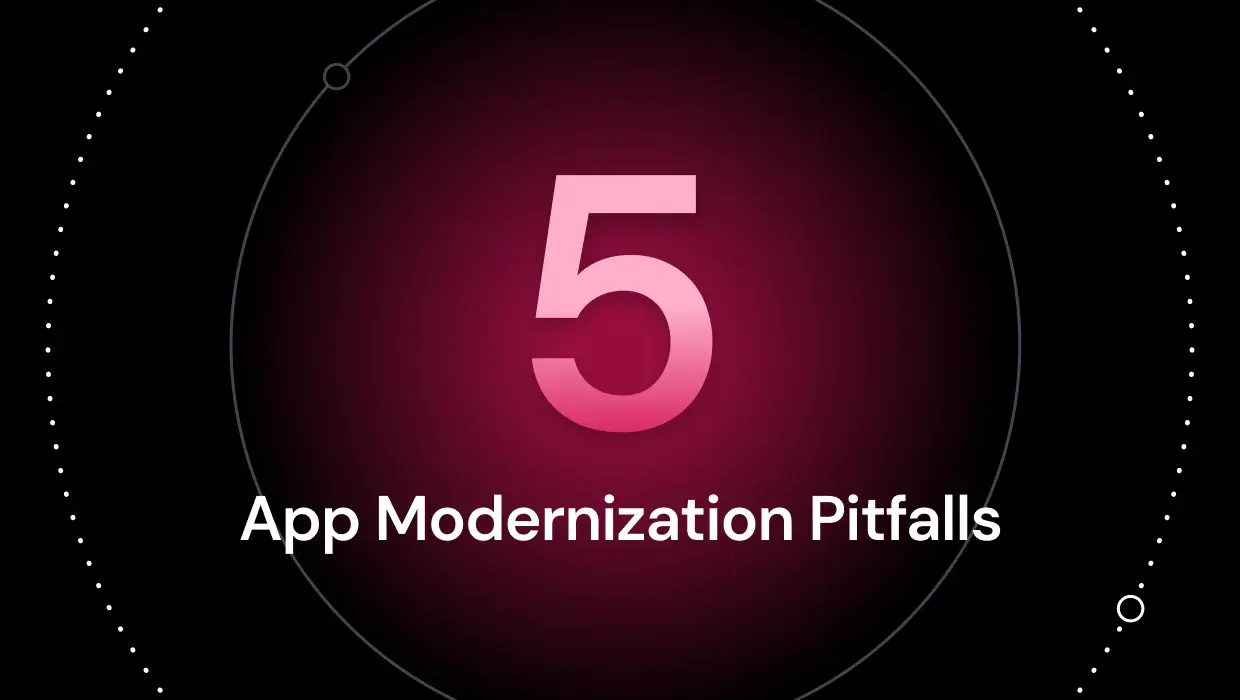After many meetings and discussions, your company has finally approved the decision to modernize a few key applications and address technical debt. That’s the good news. The bad news is the company wanted it yesterday, and you’re now scrambling to accelerate the app modernization process. Even though you provided a timeline when the project was proposed, it doesn’t matter. Once the decision-makers at your company see the value of modernization, they want to experience the benefits immediately.
It’s tempting to pick a highly visible component that is a quick fix to alleviate some of the pressure, but that can lead to bigger issues later in the process. What you need are ways to continuously modernize while you accelerate app modernization and make it a sustainable best practice.
Do You Really Need to Accelerate App Modernization?
According to a new survey of 400 decision-makers, 87% of respondents said application modernization is essential to gain a competitive edge in their market. The respondents identified four challenges to achieving their modernization goals. Those challenges included a lack of technical skills, technical debt, budget constraints, and misaligned business and technical objectives.
If organizations want to stay ahead of the competition, they must adopt new best practices that can incrementally manage and remediate technical debt and accelerate app modernization. This starts with quantifying their technical debt. Once they know the size of the problem, they can begin to address what skills are required. They can look at budget constraints and work on creating a culture that supports operations and development collaboration. The following tips can help businesses resolve the technical debt that slows application modernization.
Tip #1: Quantify Technical Debt
If you are writing code and delivering products without regard to how it’s impacting your architecture, you’re also adding to your company’s technical debt. Software projects rarely come with unlimited resources and indefinite delivery dates. Development constraints produce technical debt because there are always trade-offs between speed and quality. To avoid accumulating debt, you must manage it.
Related: Application Modernization Trends, Goals, Challenges, and Resources
As more development teams follow agile development methods, they often fail to establish practices that prevent technical debt from accumulating. Without processes that require technical debt to be addressed in later iterations, it grows until it reaches 20% to 40% of a company’s technology landscape. In a continuous development and deployment environment, continuous management of technical debt becomes crucial.
Organizations use different methods to measure technical debt. They may look at lines of code, the number of defects, or the time to deliver a fix. Trying to track technical debt using manual methods quickly becomes unmanageable. Hours are spent tabulating defects and calculating key performance indicators (KPIs) that could be used to add features and functionality.
Using automated tools, IT departments can observe operational code to quantify application and architectural debt. They can deploy automated testing tools to identify defects and highlight areas to be addressed in subsequent iterations. Automated tools apply a consistent standard to minimize ongoing debt.
Tip #2: Prioritize Efforts
Creating a roadmap for modernization requires setting priorities. IT departments must establish criteria for determining a modernization order. The process should include more than technical factors. Business needs must also be considered.
For example, developers may focus on components that restrict their ability to add new features. Executives may focus on the rising cost of maintaining legacy software. Establishing priorities makes balancing them possible.
Delivering a complete end-to-end modernized application often slows the process. Massive code changes make it difficult to troubleshoot if a problem arises. It can also extend the time to delivery as more features are added. Finally, addressing a defect quickly may be problematic and take longer to address.
Using an iterative approach, fewer code changes occur at one time. Smaller but more frequent updates allow IT teams to manage and monitor both positive and negative architectural drift using automated tools such as an Architectural Observability Platform.
Tip #3: Focus on Outcomes
Answering the fundamental question of what your modernization goal involves has a significant impact on project outcomes. It enables organizations to select the appropriate modernization strategies to achieve the desired outcome. For example, if the goal is to reduce costs, teams may retain more code than if the goal was performance. Improving application responsiveness may require a re-architecting strategy. The following strategies can help developers stay focused on the outcome.
Refactoring
Refactoring strategies allow engineers and developers to rethink how an application is architected. The strategy enables engineers to look at the architecture to determine the best modernization design. Whether serverless architecture or cloud-native applications, refactoring can point to a path that achieves a company’s goal.
The strategy can iteratively transform monolithic applications into microservices for more flexibility and better scaling than legacy solutions. It can also reduce dead code and minimize dependencies. The process can deliver a set of priorities to use in creating a modernization roadmap.
Retaining
Deciding how to respond to refactoring means finding a strategy that meets business goals. If the goal is to migrate to the cloud as quickly as possible, retaining existing code may be the primary focus. Organizations may re-platform or rehost a legacy application using a lift-and-shift approach.
This strategy allows businesses to take advantage of cloud capabilities with minimal code changes, but it doesn’t take advantage of cloud-native functionality, nor does it change the performance or agility of legacy code. It should be quickly followed up with a refactoring and re-architecting program.
Retiring
Identifying redundant code or unused functionality helps organizations optimize applications. They can remove (retire) code that is no longer needed. This process reduces the codebase that must be maintained. It eliminates lines of code that only complicate a developer’s ability to understand what is happening. Regardless of the business objective, retiring unused components simplifies the modernization process.
Repulacing
While modernization projects look at maximizing the investment in existing code, there are times when purchasing or replacing legacy applications is the most cost-effective option. For example, a 2020 survey found that 7 out of 10 applications use at least one flawed open-source library. Many of these libraries are never updated and present significant security vulnerabilities to modern applications. Any modernization strategy should include repurchasing or replacing existing code to reduce possible application vulnerabilities.
Rewriting
Rewriting may involve starting over with a blank canvas. It may mean porting code from one programming language to another. Older languages such as Fortran or Cobol do not have the same agile capabilities as Java or C#. No matter the requirement, rewriting code takes time and resources that could be used for added functionality, making it a last resort for many organizations.
Re-evaluating and Revising
Modernizing software is a continuous process, mimicking the changing business landscape. Market requirements change, businesses pivot, and technology advances. Maintaining a continuous modernization process means re-evaluating technical and architectural debt as the application landscape changes. Without an ongoing process, technical debt can grow unchecked.
Tip #4: Use Automated Tools
Automated tools can establish a continuous modernization methodology that will accelerate app modernization and prevent future drift. They can facilitate complex tasks for developers. Automated tools can help identify technical debt and where to fix it with a clear set of to-do’s. They can monitor for architectural drift and deliver insights that enable observability across an application. Without automation, continuous modernization would be almost impossible to achieve.
The following categories of automated tools can expedite workflows needed for effective modernization.
- Refactoring. As organizations look to accelerate app modernization, automated refactoring tools can expedite the process. Although not every tool offers the same functionality, automated refactoring can extract microservices, create APIs, and update frameworks. They can help untangle the dependencies in monolithic code for faster modernization.
- Testing. Automated testing tools span the development process. They can help build use cases and run tests to identify defects or weaknesses. They can perform testing much faster than staff, allowing workflows to operate smoothly.
- Monitoring. Recording how applications perform in a staging or production environment informs developers and architects of how the software behaves. It lets them know if libraries fail to load or if a microservice is slow to respond. The data can then be assessed to determine if the modernized code meets operational standards.
- Observing. Automated tools that operate across an application can deliver crucial information on how an application and its architecture behave. The view makes it easier for teams to evaluate technical and architectural drift during an application’s lifecycle.
These automated tools are just examples of the available software development tools. Given the market is expected to expand at a compound annual growth rate of 17.32% between 2022 and 2028, automation will enable architectural observability that accelerates app modernization.
Tip #5: Follow Best Practices
Application modernization has no finish line. Some organizations may reach a level of modernization that has minimal technical debt, but that is an application snapshot. As soon as a line of code is written, the opportunity for increased debt appears.
Related: Benefits of Adopting a Continuous Modernization Approach
If technical debt is allowed to grow unchecked, today’s modernization cycle will repeat. Companies will find themselves looking at software that no longer meets their business needs. Best practices for accelerating app modernization begin with establishing an environment for continuous modernization with the following:
- Quantifying Technical Debt. Continuous modernization continually analyzes technical debt. It ensures that an accurate snapshot is available at all times. Without data, organizations have a difficult time establishing an environment to accelerate app modernization.
- Establishing a Baseline. Set a baseline for an existing system and evaluate changes against that base. Once modernization is underway, decide on an acceptable level of technical and architectural debt and design processes to maintain that level.
- Prioritizing Efforts. Priorities change because business requirements change. Revisiting priorities should be part of the process. At the start of the process, the critical criteria may have been lowering costs and improving performance. Later, the priority may shift to developing an architecture that enables rapid deployment of new features. Aligning technical efforts with business objectives should remain a part of modernization best practices.
- Automating Processes. Automation can help organizations identify where to begin their modernization efforts through refactoring. Automated tools can accelerate testing and deployment. They can provide ongoing information on application behavior to ensure operational efficiencies.
- Monitoring. Using automated tools, continually monitor applications. Use traces and logs to record behavior. Without operational data, developers cannot ensure their solution works as designed.
- Observing. Software engineers must observe application operations in production. They need to see how the code behaves from end to end. They need to know more than when a failure occurs. They need to proactively evaluate performance to address weaknesses before they become failures.
Get Help with Architectural Observability for Accelerating App Modernization
An overlooked but equally important best practice is to work with a knowledgeable partner who can help build a continuous modernization best practice that will accelerate app modernization. vFunction’s modernization platform includes architectural observability, technical debt management, and monolithic application refactoring. It combines critical capabilities in a single architectural observability platform to accelerate app modernization through automation. Contact us for a demo and see how it works.





